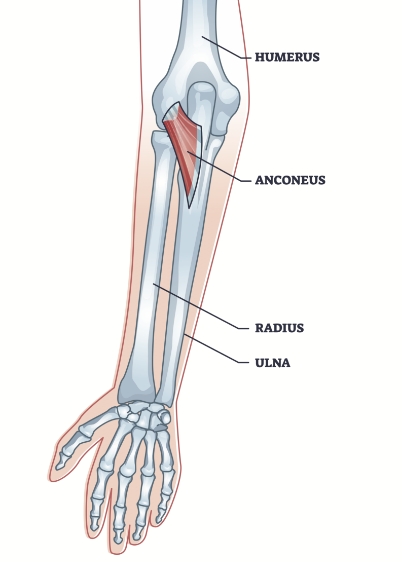Distal Radius Fracture Repair
Hand & Wrist Diseases & Conditions
A distal radius fracture is a break in the forearm bone just above the wrist. It commonly occurs when someone falls onto an outstretched hand and can cause pain, swelling, bruising, and trouble moving or gripping. Early assessment helps decide whether the wrist needs a cast or surgical repair to restore strength and movement.
Dr Oscar Brumby-Rendell is an orthopaedic surgeon in Adelaide specialising in hand and wrist injuries and treatments. He offers both surgical and non-surgical treatment options for distal radius fractures.

Understanding Distal Radius Fractures
A distal radius fracture is one of the most common types of wrist injuries. It happens when the larger forearm bone (the radius) breaks close to the wrist joint. These fractures often occur from falls, accidents, or sports injuries and can range from a simple crack to a severe break with bone displacement. Recognising the type of fracture is important because it determines whether the wrist will heal with a cast or require surgery for proper alignment.
-
Most wrist fractures involve the distal radius.
-
The break can be minor or severe, depending on the force of injury.
-
Early diagnosis helps protect long-term wrist function.
Common causes of distal radius fractures include:
A fall onto an outstretched hand (commonly called a FOOSH injury) is the leading cause of distal radius fractures. Everyday slips, trips, or sports spills can send force through the palm and break the wrist.
Older adults with osteoporosis are more at risk, as weaker bones may fracture from what looks like a simple stumble. High-impact accidents, such as cycling crashes, workplace injuries, or falls from heights, can create more severe and complex fractures. Direct blows or crushing forces, like heavy objects landing on the hand, may also cause breaks.
- Falls on an outstretched hand: The most typical cause, especially in older adults with osteoporosis.
- Sports injuries: High-impact sports or activities can lead to fractures.
- Motor vehicle accidents: Severe trauma from accidents can cause distal radius fractures.
- Direct blows: A direct impact to the wrist area can also result in a fracture.
Types of distal radius fractures include:
- Colles’ Fracture: The most common type, where the broken fragment of the radius tilts upwards.
- Smith’s Fracture: Similar to Colles’ fracture, but the broken fragment tilts downward.
- Barton’s Fracture: Involves a dislocation of the wrist joint along with the fracture.
- Chauffeur’s Fracture: A fracture of the radial styloid process, often caused by direct trauma to the wrist.
- Intra-articular Fracture: The fracture extends into the wrist joint, potentially causing joint surface irregularities.

Experience compassionate and personalised care
Symptoms of Distal Radius Fractures
Common signs and symptoms of distal radius fractures include:
- Sharp, severe pain at the wrist, worsening with movement
- Significant swelling around the wrist and forearm
- Bruising or discolouration at the injury site
- Visible deformity or abnormal positioning of the wrist
- Tenderness to touch over the fracture
- Difficulty or inability to move the wrist or hand and weakened grip


Diagnosis of Distal Radius Fractures
To confirm the type of injury, Dr Oscar Brumby-Rendell begins with a clinical examination, checking for pain, swelling, and limited wrist movement. Imaging tests are usually required to confirm the diagnosis.
X-rays show most distal radius fractures clearly, but in complicated cases, CT scans provide a three-dimensional view to guide the most accurate treatment plan. This ensures the fracture is correctly assessed before deciding between casting or surgery.
Importance of Accurate Diagnosis
Accurate diagnosis is vital for effective treatment, preventing complications, and optimising recovery. It ensures the right approach—whether casting, splinting, or surgery—while identifying associated injuries. Proper alignment and stabilisation are crucial for healing and avoiding long-term issues like chronic pain or loss of motion.
Non-Surgical Treatments for Distal Radius Fractures
Not all wrist fractures require surgery. Stable fractures where the bones remain in good alignment can often be treated with immobilisation. This usually involves a cast or splint, which allows the bone to heal naturally while preventing movement that could worsen the injury.
Regular follow-up appointments with Dr Brumby-Rendell ensure that the bone is healing correctly and has not shifted during recovery. For many patients, this approach is effective and avoids the need for an operation.
Application of a Cast: A cast is commonly applied to immobilise the wrist and allow the fractured bones to heal properly. The duration typically spans around six weeks, depending on the severity and healing progress monitored via X-rays.
Closed Reduction with Local Anaesthesia: For fractures that are out of alignment, closed reduction may be performed. This procedure involves re-aligning the bone fragments by manipulating them under local anaesthesia. After reduction, a splint or cast is applied to maintain proper alignment during the healing process.
Monitoring via X-rays: Regular X-rays are essential to monitor the healing progress and ensure that the bones remain properly aligned throughout the recovery period. Adjustments to the treatment plan, such as cast changes or modifications, may be based on these imaging results.
Physical Therapy: After the initial period of immobilisation with a cast or splint, physical therapy plays a crucial role in restoring strength, flexibility, and range of motion to the wrist and hand. Physical therapists design specific exercises and techniques to facilitate recovery and prevent stiffness.
Treatment tailored to your needs and preferences
Surgical Treatments for Distal Radius Fractures
If the fracture is unstable, displaced, or broken into multiple pieces, surgery may be the best option. Dr Brumby-Rendell uses techniques such as plates, screws, or pins to stabilise the bone and restore normal alignment.
In some cases, minimally invasive approaches are possible, reducing scarring and speeding up recovery. Surgical treatment provides the best chance of regaining strength, movement, and long-term function in complex fractures.
Surgical intervention for distal radius fractures is typically considered in the following cases:
- Misaligned Bone Fragments: When the bones are displaced and cannot be corrected through closed reduction methods.
- Neurovascular Compromise: If patients experience numbness or tingling in their fingers, indicating potential nerve or blood vessel compression.
- Open Fractures: Cases where the bone breaks through the skin, increasing the risk of infection and requiring immediate surgical management.

When treated properly, most distal radius fractures heal well with restored strength and mobility. However, untreated or poorly managed fractures may lead to ongoing pain, stiffness, arthritis, or deformity in the wrist.
In the initial phase after surgery, several key measures are essential to ensure proper healing:
- Pain Management: Medications are prescribed to control pain and reduce inflammation.
- Immobilisation: The wrist is typically immobilised with a splint to protect the surgical site and provide comfort. After surgical repair with plate and screws, patients are able to start using their wrist straight away to help prevent stiffness.
- Wound Care: Keeping the surgical incision clean and dry is crucial to prevent infection.
- Swelling Reduction: Elevation of the wrist and the use of ice packs can help reduce swelling.
Recovery and Rehabilitation
Healing doesn’t stop once the cast is removed or surgery is complete. Rehabilitation plays a major role in restoring wrist function. Hand therapy helps reduce stiffness, rebuild strength, and regain flexibility.
Recovery time varies depending on the severity of the fracture and the type of treatment used. With guidance from Dr Brumby-Rendell and a structured rehabilitation plan, most patients can return to normal daily activities while protecting their long-term wrist health.
-
Hand therapy is essential after fracture treatment.
-
Recovery timelines vary by severity and treatment type.
-
Ongoing care ensures the best long-term function.
Frequently asked questions
Seek medical help if you experience severe pain, visible deformity, or difficulty moving your wrist or hand.
Why Choose Dr Oscar Brumby-Rendell?
Dr Brumby-Rendell is an orthopaedic surgeon specialising in hand and wrist injuries with experience in both non-surgical care and modern fixation techniques.
He will review scans, explain the treatment options expected for your lifestyle, and coordinate rehabilitation with specialist hand therapists to help you regain strength and function efficiently.

Ready to learn more?
Learn more about Distal bicep injuries and other wrist-related fractures by Dr Oscar Brumby-Rendell.
Read more hand or writst-related injury treatments by Dr. Brumby-Rendell here:
Scheduling a Consultation
Experience expert care for distal radius fractures. Dr Oscar Brumby-Rendell operates from Dulwich, Bedford Park, and Stirling in Adelaide.
